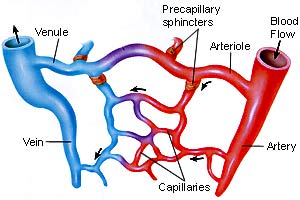Capillary Beds - definition and function

Capillary Beds are the meshlike network of arterioles and venules, the body’s tiniest BLOOD vessels, where OXYGEN–CARBON DIOXIDE EXCHANGE takes place. Arterial pressure forces blood into the capillary beds. Erythrocytes (red blood cells) carry oxygen and other NUTRIENTS to the capillary beds, where these molecules pass through to cells. Correspondingly, the cells pass metabolic waste such as CARBON DIOXIDE and lactic acid through to the blood. The arterioles and the venules intertwine in the capillary beds, becoming indistinguishable. Capillary beds are present throughout the body.
For further discussion of the capillary beds within the context of cardiovascular structure and function, please see the overview section “The Cardiovascular System.”
See also ARTERY; ERYTHROCYTE; LUNGS; VEIN.